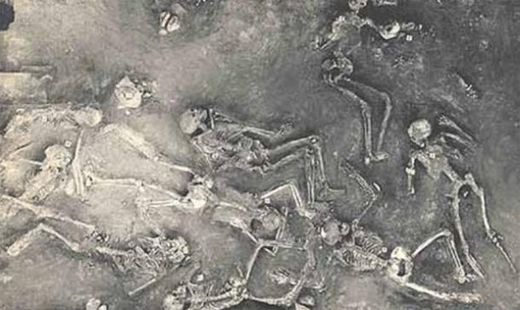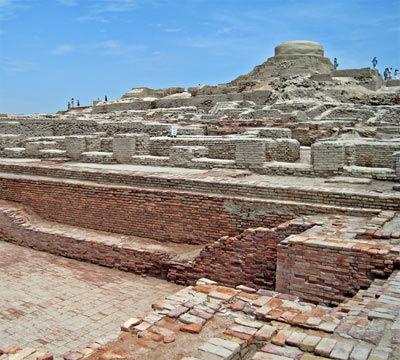
Charged with all the power of the Universe.
An incandescent column of smoke and flame
As bright as the thousand suns
Rose in all its splendor...
...it was an unknown weapon,
An iron thunderbolt,
A gigantic messenger of death,
Which reduced to ashes
The entire race of the Vrishnis and the Andhakas.
-Mahabharata, Indian Epic
However, in contrast to the well-appointed houses and clean streets, the uppermost levels at Mohenjo Daro contained squalid makeshift dwellings, a careless intermingling of residential and industrial activity and, most significantly, a series of more than 40 sprawled skeletons lying scattered in streets and houses. Paul Bahn (2002) describes the scene:
In a room with a public well in one area of the city were found the skeletons of two individuals who appeared desperately to have been using their last scraps of energy to crawl up the stair leading from the room to the street; the tumbled remains of two others lay nearby. Elsewhere in the area the 'strangely contorted' and incomplete remains of nine individuals were found, possibly thrown into a rough pit. In a lane between two houses in another area, another six skeletons were loosely covered with earth.Numerous other skeletons were found within layers of rubble, ash and debris, or lying in streets in contorted positions that suggested the agonies of violent death.
A violent massacre
The remains of these individuals led many archaeologists at the time to conclude that these people all died by violence. Sir Mortimer Wheeler, who excavated at Mohenjo Daro in 1950s, believed they were victims of a single massacre and suggested that the Indus civilization, whose demise was unexplained, had fallen to an armed invasion by Indo-Aryans, nomadic newcomers from the northwest, who are thought to have settled in India during the second millennium BC. Wheeler claimed the remains belonged to individuals who were defining the city in its final hours. He was so convincing that this theory became the accepted version of the fate of the Indus civilization.
However, many of his claims simply did not add up. There was no evidence that the skeletons belonged to 'defenders of the city' as no weapons were found and the skeletons contained no evidence of violent injuries. Some archaeologists suggested that the influx of Indo-Aryan people occurred after the decline of the Indus civilization while others questioned whether an Indo-Aryan invasion of the subcontinent even took place at all.
Flood and disease
An alternative theory was put forward that the city suffered extensive flooding and that people died off as a result of water-borne diseases such as cholera. Recent investigations revealed considerable evidence of flooding at Mohenjo Daro in the form of many layers of silty clay. The Indus River was prone to change its course and through the centuries moved gradually eastward, leading periodically to flooding within the bounds of the city. Indeed, the massive brick platforms on which the city is constructed and the fortifications around parts of it seemed to have been designed to provide protection against such floods. Conditions would have been ideal for the spread of water-borne diseases, especially cholera, although cholera epidemics cannot be proved to have occurred.
The conclusion that many mainstream archaeologists now make is that the 'massacre' victims from Mohenjo Daro were simply the victims of the natural tragedy of fatal disease rather than that of human aggression. But this conclusion also has many holes - why did the remains of individuals appear in contorted positions, almost frozen at the very moment of death? Why did they appear to have been struck down suddenly? Surely if they died of disease their bodies would have been buried and not found scattered around the city?
Evidence of atomic war?
There exist a growing number of 'alternative archaeologists' and researchers who have not settled for theories that do not satisfactorily explain the conditions of the skeletal remains and who have sought other explanations. One such individual is David Davenport, British Indian researcher, who spent 12 years studying ancient Hindu scripts and evidence at the site where the great city once stood. In his book Atomic Destruction in 2000 B.C. he reveals some startling findings: the objects found at the site appeared to be fused, glassified by a heat as high as 1500°C, followed by a sudden cooling. Within the city itself there appeared to be an 'epicentre' about 50 yards wide within which everything was crystallized, fused or melted, and sixty yards from the center the bricks are melted on one side indicating a blast. A. Gorbovsky in his book Riddles of Ancient History, reported the discovery of at least one human skeleton in the area with a level of radioactivity approximately 50 times greater than it should have been due to natural radiation. Davenport claimed that what was found at Mohenjo Daro corresponded exactly to what was seen at Nagasaki and Hiroshima.
Read the rest of the article here.




The description is unnervingly similar to the effects of an overhead cometary explosion of the Tunguska type, too.